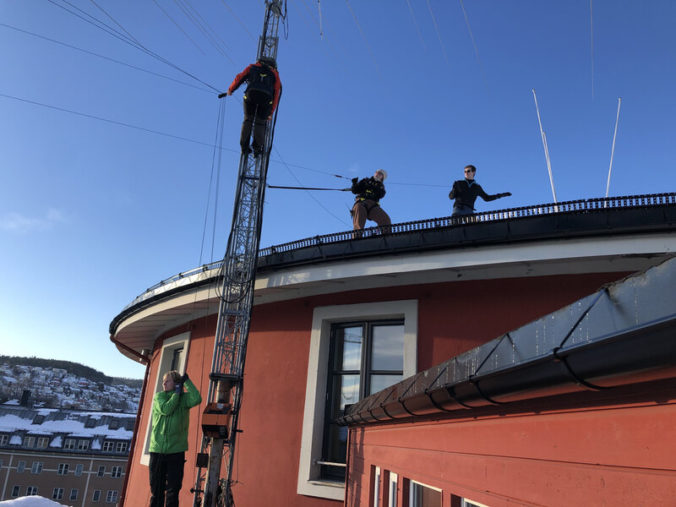Last fall, after 3 years of downtime on the 160m band, an eager gang put in the effort of finally getting the dipole elevated again. Little did they know it would last a mere 3 months before succumbing to the storm “Gyda”. Truth be told, the 160m hadn’t gotten much use but in January, LA1BFA and LB6RH were considering participation in the CW contest, “NRRL Fylkestest”, which utilizes this band. Unfortunately, just 2 days prior to the contest, strong winds blew down the antenna, and participation was scrapped. Thanks to quick reactions from LB4FI and LB6GH, the dipole was saved shortly after falling down and once again, the 160m project was added to the club agenda.

From left: LB5DH, LB8LI, Oddbjørn and LB1CJ.
(Photo: LB5PI)
We got a crew together for the execution and began early in the morning on the 27th of February. We aimed at getting the 160m up and running between “NRRL Vintertest” periods 2 and 3, which LA1K was participating in at the time. This time, instead of just replacing the rope, we had to re-thread the whole loop in the pulley on both ends.

From left: LB1CJ, LB8LI and Oddbjørn.
(Photo: LB5PI)
On the climbing team, we had climber LB1CJ and belayer Oddbjørn. At first, it seemed we didn’t have enough people to climb, but it turns out we have a far greater number of certified climbers in the club than previously assumed. LB9WI, a newly certified climber, originally called dibs to climb, but is currently away in Madeira (be on the lookout for CT3/LB9WI/P on the 20m around the Atlantic this week).

(Photo: LB1CJ)
Previous troubleshooting in January had revealed that one of the ceramic insulators keeping the loop connected had split in half, caused by incorrect installation. The ceramic insulator was mounted in the stretch direction and not in the compress direction, which is why it snapped in half. Now that we knew better, we mounted it correctly this time, as shown in the image below.

Photo: LB8LI
As there was no loop anymore, we had the climbing team carry the rope to the top and thread it through the pulley, throwing both ends down and away from the branches. At the same time, the ground crew threw a spare rope down from the roof and connected both ends in the middle of the park. This was done to avoid the branches and the traffic on the road by our clubhouse. All ropes were also carefully laid out in the park to avoid tangling. When everything was ready, we tied the spare rope to the loop and pulled it onto the roof again. Many curious passers-by had a good look!

Back: Oddbjørn, Front: LB0RI
(Photo: LB5PI)
The good thing about starting from scratch is that we avoided a spaghetti mess of wires and ropes like we had last time, one of which caused a major delay. What we couldn’t avoid regardless of what we did was the rope getting entangled in the trees by the road. At one point it got completely stuck and we had to lower everything down just to get it loose. Fortunately, we got everything back up again and went inside to take a little break and to participate in the contest!

From left: LB1CJ (climbing), LB0RI and Oddbjørn.
(Photo: LB5PI)
After the contest break and cake eating, the ones remaining adjusted the position of the antenna and elevated it above the trees. It is apparent that the trees have grown since the antenna was first installed so to avoid the wire touching the trees, the dipole had to be tighter than we would have liked. After the antenna was in place, we measured the SWR. We found that the dip occurred on the lower end of the band, and only to an SWR of 2. The bandwidth is also quite small so it doesn’t cover the whole band, but this was the case the last time the antenna was operational as well. The good news is that it covers the 10 kHz interval between 1840 kHz – 1850 kHz where Norwegians can transmit 1 kW in the SSB allocation.

(Photo: LB5DH)
With the antenna well in place LB8LI got the first QSO over FT8 later in the evening.
For a job well done, we would like to thank LB1CJ, LB5DH, LB5PI, LB8LI, LB0RI, Emil, Øyvind, Oddbjørn, Viljar, and DiverseGjengen (very cool ladder) for getting our top band up and running again. Hopefully, it will see some heavy use way before NRRL Fylkestest 2023!


Leave a Reply